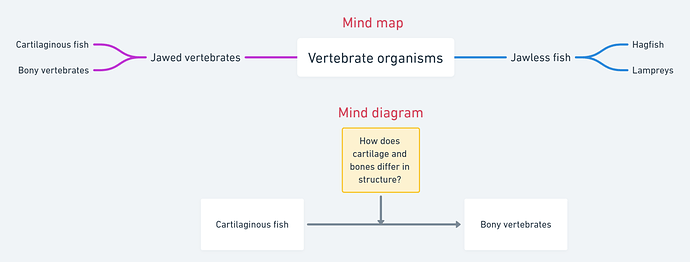I have been working with Zettelkasten in Obsidian for almost a year now, and have recently got an idea that can answer a basic question I have been struggling with:
Is the library a content overview or is it an idea generator?
I’ve recently realized that I can answer this question using the concepts “mind map” and “mind diagram.”
Mind maps are maps of the content in a topic. The purpose is to create a content overview. It is specified if two elements are connected. The goal will be to sort all relevant information in a single system.
A mind diagram is an idea generator. It specifies how two elements are connected. The goal is to include elements that contribute to thinking.
This figure illustrates the difference between a mind map and a mind diagram. Each element would be one note. Notice that in the mind diagram there are far fewer elements than in the mind map. And that in the mind diagram, an interesting question is generated by comparing two fish lineages. This question is not within taxonomy, as the first two elements are, but within cell biology.
The figure shows two different ways to visualize the connection between elements, but it also represents two different ways to build a library in Obsidian.
Why is this important?
Assessing whether you want to make a mind map or thought diagram will have a lot to say about how you prioritize time. If the intention is to create an overview on a topic, mind maps will be a suitable design. The time will be spent on finding all the elements related to a topic, and putting this into a system.
If the intention is to develop a tool that contributes to thinking and new ideas, then thought diagrams are a suitable approach. Then the time spent going in will compare individual elements, and see what kind of new thoughts arise. Here you will not spend time including all elements in the subject, but looking for new ideas.
In practice, I use both philosophies when building my library. I need both, and I vary with what I spend my time on. You can say that you do not have to choose between one of these methods in the design of the library, but that you can choose between these for each individual link you create. So, when you choose to make a link between two elements, you can ask yourself:
Is the most important thing to show that these elements are connected, or should I show how they are connected?
I’d be grateful for feedback on this line of thought.
Regards,
Battle beaver
